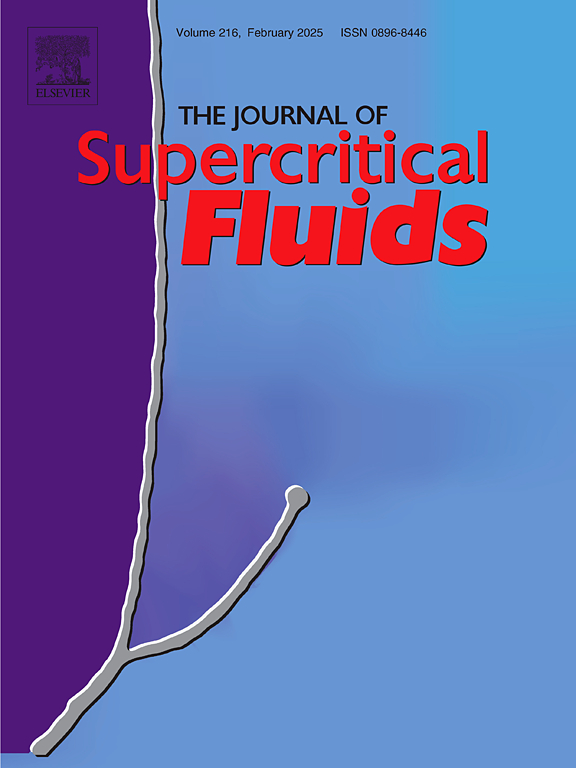Phase behavior of carbon dioxide/dioctyl phthalate and trioctyl trimellitate systems
IF 4.4
3区 工程技术
Q2 CHEMISTRY, PHYSICAL
引用次数: 0
Abstract
Phthalate plasticizers, which are widely used as general-purpose plasticizers for polyvinyl chloride (PVC), have been identified as harmful to human health. This has created a pressing need to separate these substances from PVC products. In addition, the potential contamination of trioctyl trimellitate (TOTM), an alternative to phthalate plasticizers, with dioctyl phthalate (DOP) cannot be overlooked. Supercritical carbon dioxide (scCO2) has been proposed as a solvent for extracting and separating these compounds; therefore, understanding the phase behavior of these systems is critical for optimizing the process design. This study investigated the phase behavior of CO2/DOP and CO2/TOTM binary systems using a synthetic method combined with a laser displacement technique to measure the movement of the piston in a high-pressure vessel. The phase boundaries were determined over temperature and CO2 mole fraction ranges of (313–373) K and (0.2–0.9), respectively. The vapor–liquid equilibria of the two experimentally obtained binary systems were correlated using the Sanchez-Lacombe equation of state. The one- and two-parameter mixing rules were tested, with better correlation over a wide composition range achieved using the two-parameter mixing rule. The results of this study imply that while separating DOP and TOTM using scCO2 may be challenging, scCO2 shows great potential as an extraction solvent for both plasticizers.
二氧化碳/邻苯二甲酸二辛酯和三甲基酸三辛酯体系的相行为
邻苯二甲酸酯增塑剂是广泛用于聚氯乙烯(PVC)的通用增塑剂,已被确定对人体健康有害。这就产生了从PVC产品中分离这些物质的迫切需要。此外,邻苯二甲酸二辛酯(DOP)对邻苯二甲酸二辛酯增塑剂的潜在污染也不容忽视。超临界二氧化碳(scCO2)被提议作为萃取分离这些化合物的溶剂;因此,了解这些系统的相行为对于优化工艺设计至关重要。本研究利用激光位移技术结合合成方法研究了CO2/DOP和CO2/TOTM二元体系的相行为,以测量高压容器中活塞的运动。在温度范围(313 ~ 373) K和(0.2 ~ 0.9)CO2摩尔分数范围内确定了相界。用Sanchez-Lacombe状态方程对实验得到的两种二元体系的气液平衡进行了关联。测试了单参数和双参数混合规则,使用双参数混合规则在较宽的成分范围内获得了更好的相关性。本研究的结果表明,虽然使用scCO2分离DOP和TOTM可能具有挑战性,但scCO2作为两种增塑剂的萃取溶剂具有很大的潜力。
本文章由计算机程序翻译,如有差异,请以英文原文为准。
求助全文
约1分钟内获得全文
求助全文
来源期刊

Journal of Supercritical Fluids
工程技术-工程:化工
CiteScore
7.60
自引率
10.30%
发文量
236
审稿时长
56 days
期刊介绍:
The Journal of Supercritical Fluids is an international journal devoted to the fundamental and applied aspects of supercritical fluids and processes. Its aim is to provide a focused platform for academic and industrial researchers to report their findings and to have ready access to the advances in this rapidly growing field. Its coverage is multidisciplinary and includes both basic and applied topics.
Thermodynamics and phase equilibria, reaction kinetics and rate processes, thermal and transport properties, and all topics related to processing such as separations (extraction, fractionation, purification, chromatography) nucleation and impregnation are within the scope. Accounts of specific engineering applications such as those encountered in food, fuel, natural products, minerals, pharmaceuticals and polymer industries are included. Topics related to high pressure equipment design, analytical techniques, sensors, and process control methodologies are also within the scope of the journal.
 求助内容:
求助内容: 应助结果提醒方式:
应助结果提醒方式:


